Fibula Graft Cutting Devices: Are 3D-Printed Cutting Guides More Precise than a Universal, Reusable Osteotomy Jig?
Abstract
1. Introduction
2. Material and Methods
2.1. The Multi-Use Cutting Jig (MUC-Jig)
2.2. Three-Dimensional-Printed Cutting Guide
2.3. Study Model
2.4. In Vitro Surgery
2.5. Evaluation
2.5.1. Participant Information
2.5.2. Segment Analysis
| Segment length locations | Osteotomy angles | ||
| A: ventral most | C: lateral most | αp and αd: | angle in the coronal plane |
| B: dorsal most | D: medial most | βp and βd: | angle in the sagittal plane |
2.5.3. Intervention Time
- MUC-Jig: The time required for the attachment to the fibula, setting the fence before each cut, and for the removal of the cutting jig.
- Cutting guide: The time required to fix the guide to the fibula with screws and for the removal of the cutting guide.
2.5.4. Surgeons’ Subjective Perception of the Osteotomies
2.6. Statistics
3. Results
3.1. Demographic Variables
3.2. Three-Dimensional Analysis
- Tx2 (−0.05 ± 0.89 mm) and Tx4 (−0.29 ± 0.92 mm) of the MUC-Jig group were significantly shorter compared to the template group (0.28 ± 0.83; 0.35 ± 0.74 mm; p = 0.024; p = 0.003).
- No significant relative differences (p > 0.05) between the segments within both groups were found.
- Tx1 (MUC-Jig: 1.28 ± 1.03 mm) showed a significant mean absolute length deviation between the groups (template: 0.78 ± 0.77 mm; p = 0.016) and within the MUC-Jig group (p ≤ 0.009) compared to the other segments (Tx2: 0.70 ± 0.54; Tx3: 0.64 ± 0.55; Tx4: 0.64 ± 0.71 mm).
- Section A (−0.49 ± 0.76; 0.67 ± 0.60 mm) of the MUC-Jig group showed a significant mean relative (p = 4.61 × 10−7) and absolute (p = 0.007) difference, as compared to the template group (0.28 ± 0.37; 0.35 ± 0.31 mm).
- Tx1–Tx4 (−0.36–−0.69 mm ± 0.65–1.01 mm) of the MUC-Jig group were significantly (p ≤ 0.05) shorter in section A than those of the template group (0.12–0.48 ± 0.26°–0.48°). However, only Tx1 (0.65 ± 0.48 mm) and Tx3 (0.72 ± 0.62 mm) of the MUC-Jig group also showed a significantly (p = 0.014; p = 0.049) larger absolute deviation from the planning in this section than the template (Tx1: 0.23 ± 0.16; Tx3: 0.29 ± 0.29 mm) group did.
- Sections A (−0.49 ± 0.76 mm) and D (−0.74 ± 1.24 mm) within the MUC-Jig group were shorter than the planning parameters and differed significantly (p ≤ 0.001) from B (0.40 ± 0.99 mm) and C (0.50 ± 0.94 mm), but not in the absolute deviation (p > 0.05).
- Sections A (0.28 ± 0.37 mm) and D (−0.47 ± 1.07 mm) within the template group were significantly shorter than C (0.64 ± 0.67 mm) and D (p ≤ 0.003) and A, B (0.44 ± 0.91 mm), and C (p ≤ 8.39 × 10−6), respectively, but did not differ significantly concerning the absolute deviation (p > 0.05).
- Tx1 (−2.04° ± 3.71°) and Tx2 (−1.07° ± 2.52°) of the MUC-Jig group showed smaller mean angles than the planning parameters and differed significantly (p = 0.001; p = 0.019) with respect to the relative deviation from the template group (Tx1: 0.05° ± 2.65°; Tx2: 0.05° ± 2.66°).
- Tx1 and Tx2 within the MUC-Jig group showed smaller mean angles compared to the planning parameters and also differed significantly (p ≤ 0.05) from Tx3 (−0.07° ± 2.84°) and Tx4 (0.44° ± 2.95°).
- Tx4 (1.20° ± 2.37°) also differed significantly from Tx1, Tx2, and Tx3 (0.15° ± 2.56°) within the template group in terms of a too large angle (p ≤ 0.05).
- No significant (p > 0.05) mean absolute angular deviations of the transplants between and within the groups were observed.
- All mean angles of the MUC-Jig group were significantly smaller (p ≤ 0.05) compared to the template group, with the exception of the αd angle, but no significant difference (p > 0.05) could be found with regard to the absolute deviation from the planning at all angles.
- In both groups (MUC-Jig (J); template (T)), the variable angles (βp (J: −2.06° ± 2.87°; T: −1.05° ± 2.43°), and αd (J: −1.23° ± 4.22°; T: −0.89° ± 2.26°)) were, on average, smaller than the planning parameters, and at the same time they deviated significantly (p ≤ 0.05) from the fixed angles (αp (J: 0.83° ± 1.98°; T: 2.00° ± 2.30°), and βd (J: −0.28° ± 2.42°; T: 1.40° ± 1.86°)), which tended to be larger than the planning parameters.
- There were no significant absolute deviations between or within the groups (p > 0.05).
3.3. Intervention Times
3.4. Surgeons’ Subjective Perception
4. Discussion
5. Conclusions
Author Contributions
Funding
Acknowledgments
Conflicts of Interest
Financial Disclosure
Product List:
- Multi-Use Cutting Jig (self-developed—design JM Hirsch and CS Leiggener in collaboration with Ralf Schumacher, University of Applied Sciences and Arts Northwestern Switzerland and Ångström Workshop Uppsala University, Uppsala Sweden who also manufactured the Multi-Use Cutting Jig)
- 3D-printed cutting guide (Objet30 V3 using MED610 with SUP706, Stratasys, Ltd., Eden Prairie, MN, USA)
- Planning software (Mimics Innovation Suite, V20, Materialise, Leuven, Belgium)
- Overhead camera (iPhone 7, Apple, Cupertino, United States of America)
- Colibri system (Colibri II, DePuy Synthes, Oberdorf, Switzerland)
- AO/ASIF Quick Coupling (05.001.250, DePuy Synthes, Oberdorf, Switzerland)
- Drill (310.110, DePuy Synthes, Oberdorf, Switzerland)
- Oscillating Saw Attachment (532.021, DePuy Synthes, Oberdorf, Switzerland)
- Saw blade (532.064, DePuy Synthes, Oberdorf, Switzerland).
- Screws (Spax 2 × 12 mm Senkkopf, SPAX International GmbH & Co. KG, Ennepetal, Germany).
- 3D-printer (MakerBot Replicator+, MakerBot Industries, NY, USA)
- PLA (MakerBot Filament, 1.75 mm, 0.9 kg, MakerBot Industries, NY, USA).
- Pencil (Write-4-All Permanent Marker, size F, black, STABILO International GmbH, Heroldsberg, Germany)
- Stainless steel ruler (Lineal 50 cm Stahl, Veto, Alphen aan den Rijn, The Netherlands)
Abbreviations
| 3D | Three-dimensional |
| CMF | Cranio-maxillofacial |
| CNC | Computer numerical control |
| MAM | Medical additive manufacturing |
| MUC-Jig | Multi-Use Cutting Jig |
| PLA | Polylactic acid |
| p | p-value |
| SD | Standard deviation |
| Tx | Transplant |
| USD | United States Dollar |
| VAS | Visual analogue scale |
| VSP | Virtual Surgical Planning |
References
- Hidalgo, D.A. Fibula free flap: A new method of mandible reconstruction. Plast. Reconstr. Surg. 1989, 84, 71–79. [Google Scholar] [CrossRef] [PubMed]
- Fernandes, R. An Easy Method for Predictable Osteotomies in the Vascularized Fibula Flap for Mandibular Reconstruction. J. Oral Maxillofac. Surg. 2007, 65, 1874–1875. [Google Scholar] [CrossRef] [PubMed]
- Moro, A.; Cannas, R.; Boniello, R.; Gasparini, G.; Pelo, S. Techniques on Modeling the Vascularized Free Fibula Flap in Mandibular Reconstruction. J. Craniofacial Surg. 2009, 20, 1571–1573. [Google Scholar] [CrossRef] [PubMed]
- Hallermann, W.; Olsen, S.; Bardyn, T.; Taghizadeh, F.; Banic, A.; Iizuka, T. A New Method for Computer-Aided Operation Planning for Extensive Mandibular Reconstruction. Plast. Reconstr. Surg. 2006, 117, 2431–2437. [Google Scholar] [CrossRef]
- Dérand, P.; Rännar, L.-E.; Hirsch, J.-M. Imaging, Virtual Planning, Design, and Production of Patient-Specific Implants and Clinical Validation in Craniomaxillofacial Surgery. Craniomaxillofac. Trauma Reconstr. 2012, 5, 137–143. [Google Scholar] [CrossRef]
- Thor, A.; Rojas, R.A.; Hirsch, J.-M. Functional reconstruction of the temporomandibular joint with a free fibular microvascular flap. Scand. J. Plast. Reconstr. Surg. Hand Surg. 2008, 42, 233–240. [Google Scholar] [CrossRef]
- Strackee, S.D.; Kroon, F.H.M.; Spierings, P.T.J.; Jaspers, J.E.N. Development of a Modeling and Osteotomy Jig System for Reconstruction of the Mandible with a Free Vascularized Fibula Flap. Plast. Reconstr. Surg. 2004, 114, 1851–1858. [Google Scholar] [CrossRef]
- Xu, L.-Q.; Zhang, C.-P.; Poh, E.H.-K.; Yin, X.-L.; Shen, S.-K. A Novel Fibula Osteotomy Guide for Mandibular Reconstruction. Plast. Reconstr. Surg. 2012, 129, 861e–863e. [Google Scholar] [CrossRef]
- Weitz, J.; Wolff, K.-D.; Kesting, M.R.; Nobis, C.-P. Development of a novel resection and cutting guide for mandibular reconstruction using free fibula flap. J. Cranio-Maxillofac. Surg. 2018, 46, 1975–1978. [Google Scholar] [CrossRef] [PubMed]
- Leiggener, C.; Messo, E.; Thor, A.; Zeilhofer, H.-F.; Hirsch, J.-M. A selective laser sintering guide for transferring a virtual plan to real time surgery in composite mandibular reconstruction with free fibula osseous flaps. Int. J. Oral Maxillofac. Surg. 2009, 38, 187–192. [Google Scholar] [CrossRef] [PubMed]
- Król, Z.; Chlebiej, M.; Zerfass, P.; Zeilhofer, H.F.; Sader, R.; Mikołajczak, P.; Keeve, E. Patient-Specific graft design method for craniofacial surgical planning. J. Med. Infrom. Technol. 2002, 3, 189–198. [Google Scholar]
- Dérand, P.; Hirsch, J.-M. Virtual Bending of Mandibular Reconstruction Plates Using a Computer-Aided Design. J. Oral Maxillofac. Surg. 2009, 67, 1640–1643. [Google Scholar] [CrossRef] [PubMed]
- De Maesschalck, T.; Courvoisier, D.S.; Scolozzi, P. Computer-assisted versus traditional freehand technique in fibular free flap mandibular reconstruction: A morphological comparative study. Eur. Arch. Oto-Rhino-Laryngol. 2016, 274, 517–526. [Google Scholar] [CrossRef] [PubMed]
- Bartier, S.; Mazzaschi, O.; Benichou, L.; Sauvaget, E. Computer-assisted versus traditional technique in fibular free-flap mandibular reconstruction: A CT symmetry study. Eur. Ann. Otorhinolaryngol. Head Neck Dis. 2020, 2020, 6–10. [Google Scholar] [CrossRef]
- Ren, W.; Gao, L.; Li, S.; Chen, C.; Li, F.; Wang, Q.; Zhi, Y.; Song, J.; Dou, Z.; Xue, L.; et al. Virtual Planning and 3D printing modeling for mandibular reconstruction with fibula free flap. Medicina Oral Patología Oral y Cirugia Bucal 2018, 23, e359–e366. [Google Scholar] [CrossRef]
- Metzler, P.; Geiger, E.J.; Alcon, A.; Ma, X.; Steinbacher, D. Three-Dimensional Virtual Surgery Accuracy for Free Fibula Mandibular Reconstruction: Planned Versus Actual Results. J. Oral Maxillofac. Surg. 2014, 72, 2601–2612. [Google Scholar] [CrossRef]
- Succo, G.; Berrone, M.; Battiston, B.; Tos, P.; Goia, F.; Appendino, P.; Crosetti, E. Step-by-step surgical technique for mandibular reconstruction with fibular free flap: Application of digital technology in virtual surgical planning. Eur. Arch. Oto-Rhino-Laryngol. 2014, 272, 1491–1501. [Google Scholar] [CrossRef]
- Dong, Z.; Li, B.; Xie, R.; Wu, Q.; Zhang, L.; Bai, S. Comparative study of three kinds of fibula cutting guides in reshaping fibula for the reconstruction of mandible: An accuracy simulation study in vitro. J. Cranio-Maxillofac. Surg. 2017, 45, 1227–1235. [Google Scholar] [CrossRef]
- Wang, Y.; Zhang, H.; Fan, S.; Zhang, D.; Huang, Z.; Chen, W.; Ye, J.; Li, J. Mandibular reconstruction with the vascularized fibula flap: Comparison of virtual planning surgery and conventional surgery. Int. J. Oral Maxillofac. Surg. 2016, 45, 1400–1405. [Google Scholar] [CrossRef]
- Zweifel, D.F.; Simon, C.; Hoarau, R.; Pasche, P.; Broome, M. Are Virtual Planning and Guided Surgery for Head and Neck Reconstruction Economically Viable? J. Oral Maxillofac. Surg. 2015, 73, 170–175. [Google Scholar] [CrossRef]
- Meyer, S.; Hirsch, J.-M.; Leiggener, C.S.; Zeilhofer, H.-F.; Thieringer, F.M. A simple, effective, universal, and reusable osteotomy tool for jaw reconstructions with microvascular fibula transplants. J. Plast. Reconstr. Aesthet. Surg. 2019, 73, 98–102. [Google Scholar] [CrossRef] [PubMed]
- Shu, D.-L.; Liu, X.-Z.; Guo, B.; Ran, W.; Liao, X.; Zhang, Y.-Y. Accuracy of using computer-aided rapid prototyping templates for mandible reconstruction with an iliac crest graft. World J. Surg. Oncol. 2014, 12, 190. [Google Scholar] [CrossRef] [PubMed]
- Roser, S.M.; Ramachandra, S.; Blair, H.; Grist, W.; Carlson, G.W.; Christensen, A.M.; Weimer, K.A.; Steed, M.B. The Accuracy of Virtual Surgical Planning in Free Fibula Mandibular Reconstruction: Comparison of Planned and Final Results. J. Oral Maxillofac. Surg. 2010, 68, 2824–2832. [Google Scholar] [CrossRef] [PubMed]
- Numajiri, T.; Nakamura, H.; Sowa, Y.; Nishino, K. Low-cost Design and Manufacturing of Surgical Guides for Mandibular Reconstruction Using a Fibula. Plast. Reconstr. Surg. Glob. Open 2016, 4, e805. [Google Scholar] [CrossRef]
- Lim, S.-H.; Kim, Y.-H.; Kim, M.-K.; Nam, W.; Kang, S.-H. Validation of a fibula graft cutting guide for mandibular reconstruction: Experiment with rapid prototyping mandible model. Comput. Assist. Surg. 2016, 21, 9–17. [Google Scholar] [CrossRef]
- Zheng, G.-S.; Su, Y.-X.; Liao, G.-Q.; Chen, Z.-F.; Wang, L.; Jiao, P.-F.; Liu, H.-C.; Zhong, Y.-Q.; Zhang, T.-H.; Liang, Y.-J.; et al. Mandible reconstruction assisted by preoperative virtual surgical simulation. Oral Surg. Oral Med. Oral Pathol. Oral Radiol. 2012, 113, 604–611. [Google Scholar] [CrossRef]
- Yu, Y.; Zhang, W.-B.; Liu, X.-J.; Guo, C.-B.; Yu, G.-Y.; Peng, X.; Yu, Y.; Zhang, W.-B.; Liu, X.; Guo, Y.; et al. Three-Dimensional Accuracy of Virtual Planning and Surgical Navigation for Mandibular Reconstruction With Free Fibula Flap. J. Oral Maxillofac. Surg. 2016, 74, 1503.e1–1503.e100. [Google Scholar] [CrossRef]
- Shaw, R.J.; Kanatas, A.N.; Lowe, D.; Brown, J.S.; Rogers, S.N.; Vaughan, E.D. Comparison of miniplates and reconstruction plates in mandibular reconstruction. Head Neck 2004, 26, 456–463. [Google Scholar] [CrossRef]
- Zhang, Z.-L.; Wang, S.; Sun, C.-F.; Xu, Z.-F. Miniplates Versus Reconstruction Plates in Vascularized Osteocutaneous Flap Reconstruction of the Mandible. J. Craniofacial Surg. 2019, 30, E119–E125. [Google Scholar] [CrossRef]
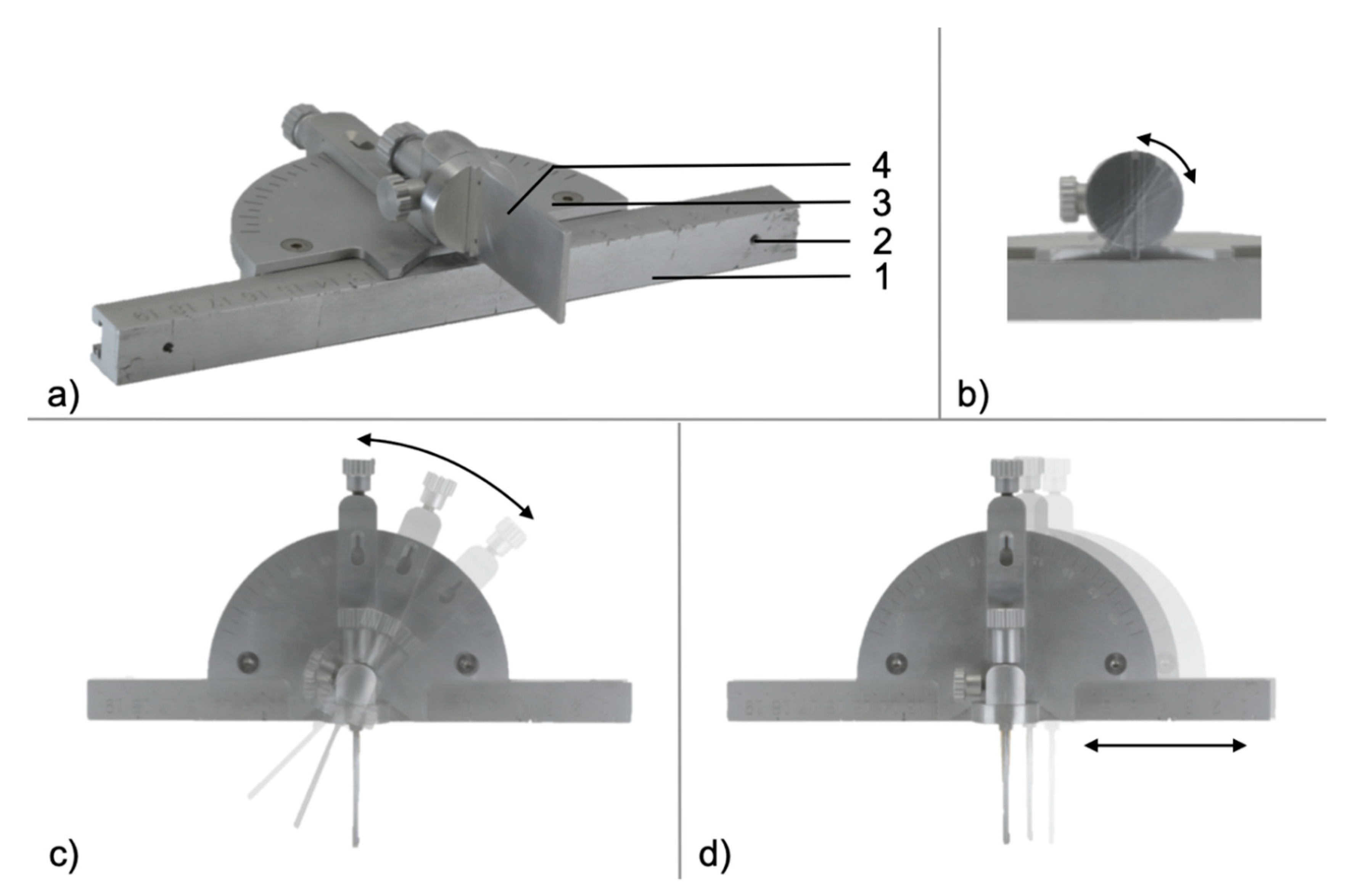

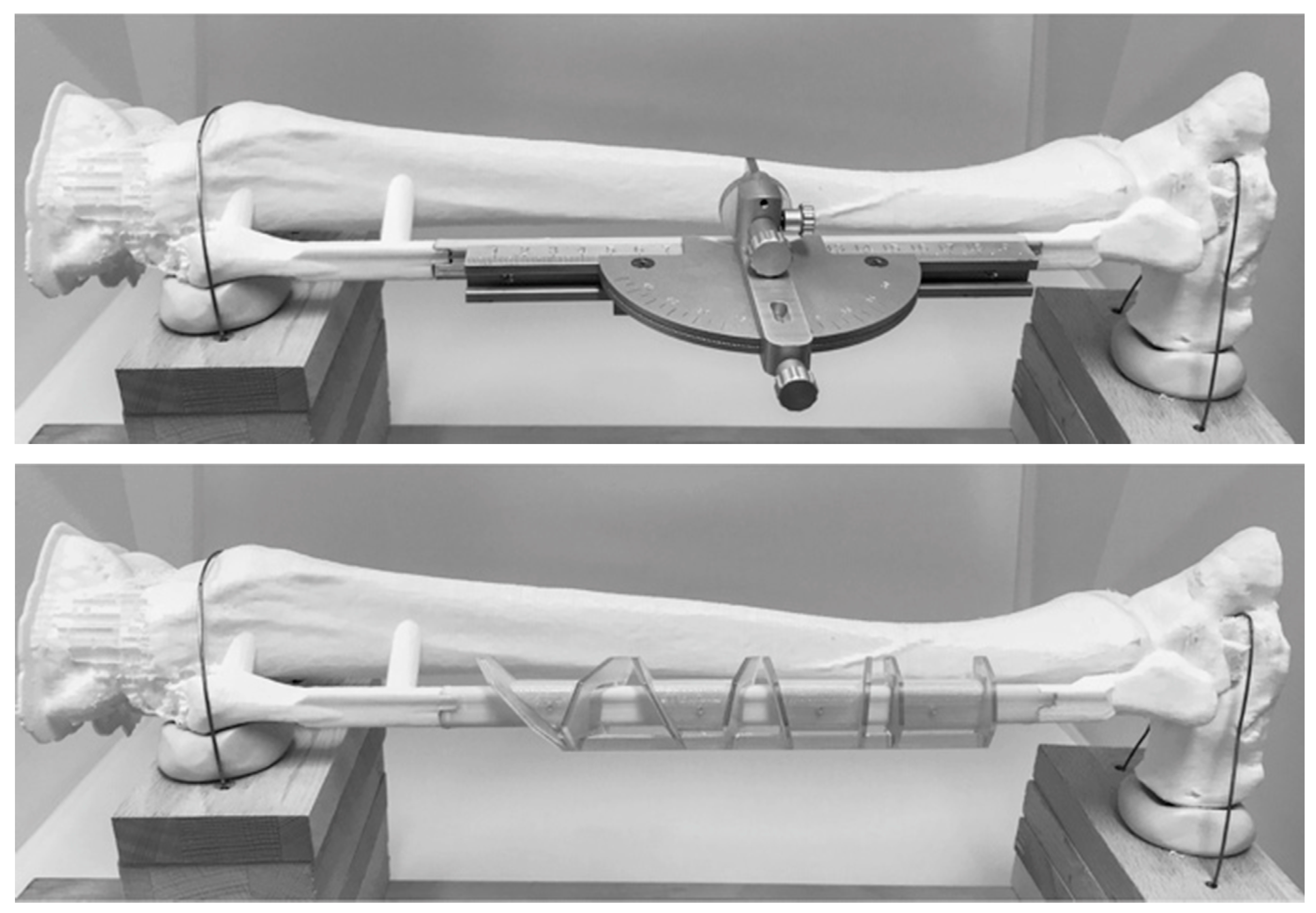
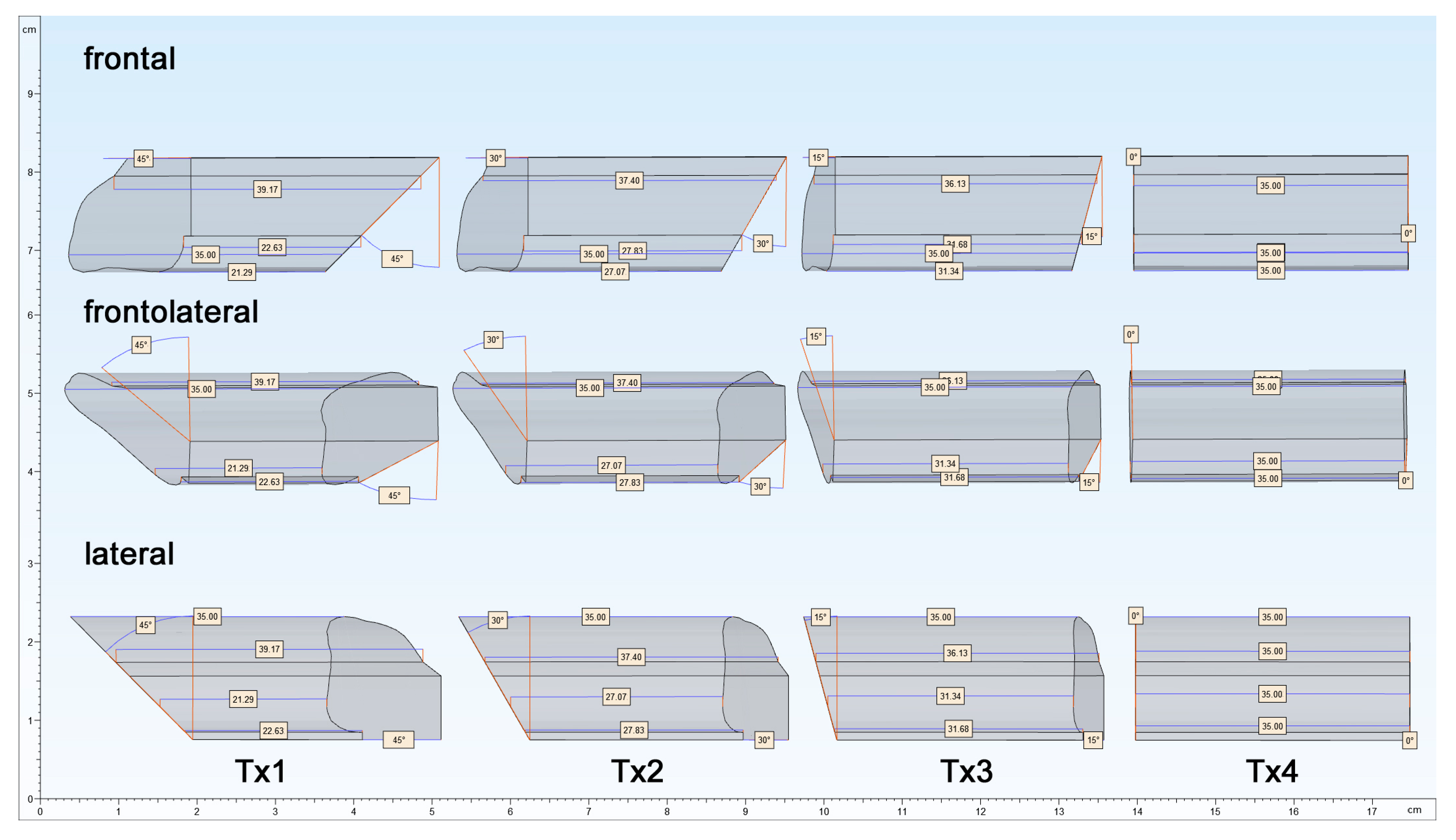

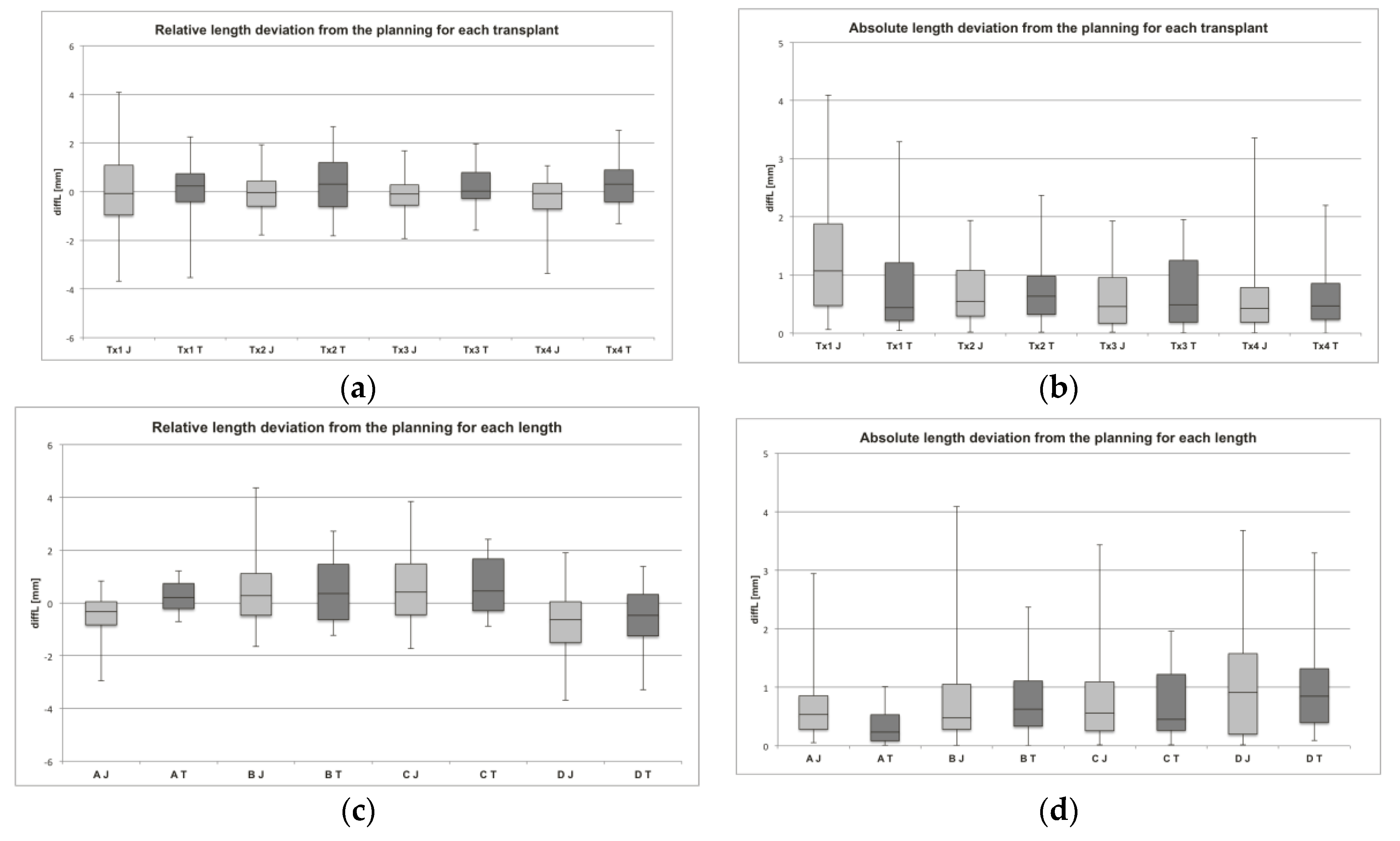
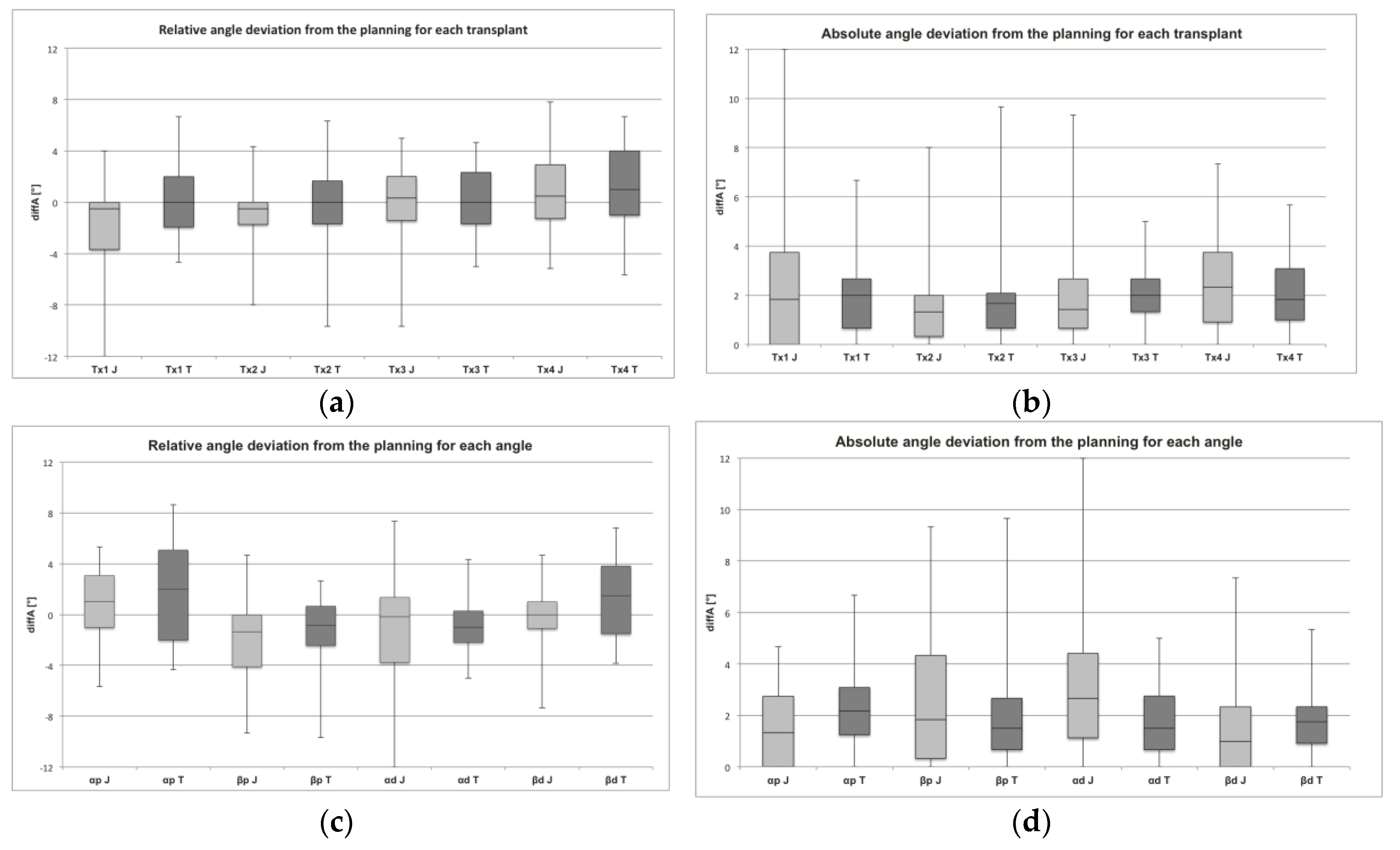

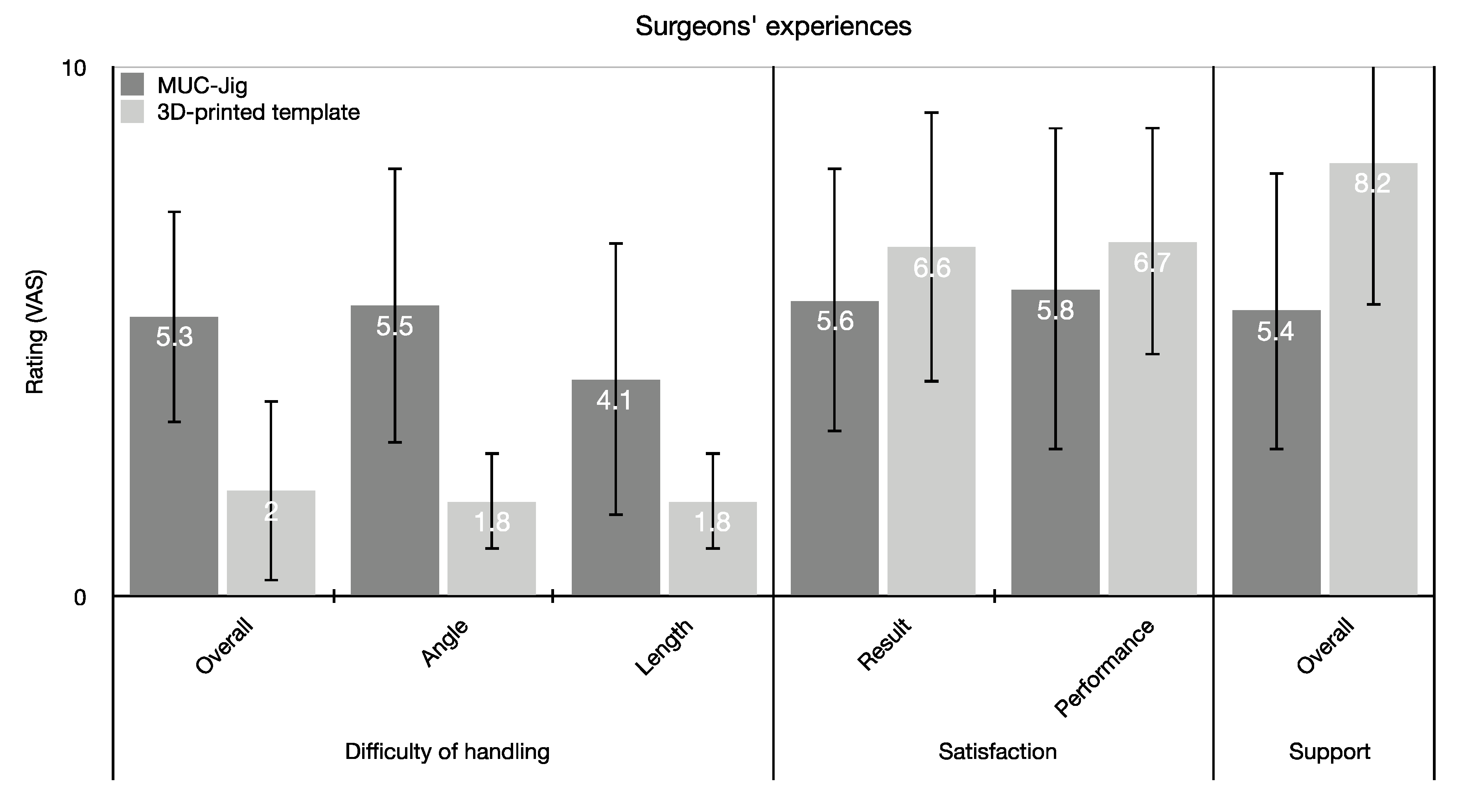
| Sex | Age (y) | Experience (y) | Fibula Txs | |||
|---|---|---|---|---|---|---|
| ♀ | ♂ | Performed | Assisted | |||
| Consultants | 1 | 4 | 47.20 (±8.87) | 16.80 (±7.66) | 7.40 (±8.59) | 14.00 (±5.48) |
| Residents | 1 | 4 | 35.80 (±2.49) | 5.50 (±2.69) | 0.00 | 16.40 (±14.45) |
| Total | 2 | 8 | 41.44 (±8.59) | 11.15 (±8.05) | 3.70 (±6.92) | 15.20 (±10.38) |
Publisher’s Note: MDPI stays neutral with regard to jurisdictional claims in published maps and institutional affiliations. |
© 2020 by the authors. Licensee MDPI, Basel, Switzerland. This article is an open access article distributed under the terms and conditions of the Creative Commons Attribution (CC BY) license (http://creativecommons.org/licenses/by/4.0/).
Share and Cite
Meyer, S.; Hirsch, J.-M.; Leiggener, C.S.; Msallem, B.; Sigron, G.R.; Kunz, C.; Thieringer, F.M. Fibula Graft Cutting Devices: Are 3D-Printed Cutting Guides More Precise than a Universal, Reusable Osteotomy Jig? J. Clin. Med. 2020, 9, 4119. https://doi.org/10.3390/jcm9124119
Meyer S, Hirsch J-M, Leiggener CS, Msallem B, Sigron GR, Kunz C, Thieringer FM. Fibula Graft Cutting Devices: Are 3D-Printed Cutting Guides More Precise than a Universal, Reusable Osteotomy Jig? Journal of Clinical Medicine. 2020; 9(12):4119. https://doi.org/10.3390/jcm9124119
Chicago/Turabian StyleMeyer, Simon, Jan-Michaél Hirsch, Christoph S. Leiggener, Bilal Msallem, Guido R. Sigron, Christoph Kunz, and Florian M. Thieringer. 2020. "Fibula Graft Cutting Devices: Are 3D-Printed Cutting Guides More Precise than a Universal, Reusable Osteotomy Jig?" Journal of Clinical Medicine 9, no. 12: 4119. https://doi.org/10.3390/jcm9124119
APA StyleMeyer, S., Hirsch, J.-M., Leiggener, C. S., Msallem, B., Sigron, G. R., Kunz, C., & Thieringer, F. M. (2020). Fibula Graft Cutting Devices: Are 3D-Printed Cutting Guides More Precise than a Universal, Reusable Osteotomy Jig? Journal of Clinical Medicine, 9(12), 4119. https://doi.org/10.3390/jcm9124119






